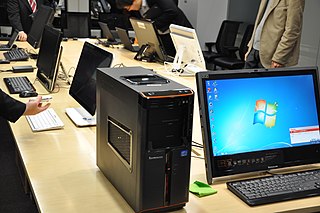
Gesture recognition is an area of research and development in computer science and language technology concerned with the recognition and interpretation of human gestures. A subdiscipline of computer vision, it employs mathematical algorithms to interpret gestures.

A stereo camera is a type of camera with two or more lenses with a separate image sensor or film frame for each lens. This allows the camera to simulate human binocular vision, and therefore gives it the ability to capture three-dimensional images, a process known as stereo photography. Stereo cameras may be used for making stereoviews and 3D pictures for movies, or for range imaging. The distance between the lenses in a typical stereo camera is about the distance between one's eyes and is about 6.35 cm, though a longer base line produces more extreme 3-dimensionality.
The stereo cameras approach is a method of distilling a noisy video signal into a coherent data set that a computer can begin to process into actionable symbolic objects, or abstractions. Stereo cameras is one of many approaches used in the broader fields of computer vision and machine vision.

Microsoft PixelSense was an interactive surface computing platform that allowed one or more people to use and touch real-world objects, and share digital content at the same time. The PixelSense platform consists of software and hardware products that combine vision based multitouch PC hardware, 360-degree multiuser application design, and Windows software to create a natural user interface (NUI).

An image processor, also known as an image processing engine, image processing unit (IPU), or image signal processor (ISP), is a type of media processor or specialized digital signal processor (DSP) used for image processing, in digital cameras or other devices. Image processors often employ parallel computing even with SIMD or MIMD technologies to increase speed and efficiency. The digital image processing engine can perform a range of tasks. To increase the system integration on embedded devices, often it is a system on a chip with multi-core processor architecture.

2D-plus-Depth is a stereoscopic video coding format that is used for 3D displays, such as Philips WOWvx. Philips discontinued work on the WOWvx line in 2009, citing "current market developments". Currently, this Philips technology is used by SeeCubic company, led by former key 3D engineers and scientists of Philips. They offer autostereoscopic 3D displays which use the 2D-plus-Depth format for 3D video input.

A time-of-flight camera, also known as time-of-flight sensor, is a range imaging camera system for measuring distances between the camera and the subject for each point of the image based on time-of-flight, the round trip time of an artificial light signal, as provided by a laser or an LED. Laser-based time-of-flight cameras are part of a broader class of scannerless LIDAR, in which the entire scene is captured with each laser pulse, as opposed to point-by-point with a laser beam such as in scanning LIDAR systems. Time-of-flight camera products for civil applications began to emerge around 2000, as the semiconductor processes allowed the production of components fast enough for such devices. The systems cover ranges of a few centimeters up to several kilometers.
Sony Depthsensing Solutions SA/NV, formerly known as SoftKinetic Systems, is a Belgian company originating from the merger of Optrima NV, founded by André Miodezky, Maarten Kuijk, Daniël Van Nieuwenhove, Ward Van der Tempel, Riemer Grootjans and Tomas Van den Hauwe and SoftKinetic SA founded by Eric Krzeslo, Thibaud Remacle, Gilles Pinault and Xavier Baele. Sony Depthsensing Solutions develops gesture recognition hardware and software for real-time range imaging (3D) cameras. SoftKinetic was founded in July 2007 providing gesture recognition solutions based on its technology to the interactive digital entertainment, consumer electronics, health & fitness, and serious game industries. SoftKinetic technology has been applied to interactive digital signage and advergaming, interactive television, and physical therapy.

Kinect is a discontinued line of motion sensing input devices produced by Microsoft and first released in 2010. The devices generally contain RGB cameras, and infrared projectors and detectors that map depth through either structured light or time of flight calculations, which can in turn be used to perform real-time gesture recognition and body skeletal detection, among other capabilities. They also contain microphones that can be used for speech recognition and voice control.
Rockchip is a Chinese fabless semiconductor company based in Fuzhou, Fujian province. It has offices in Shanghai, Beijing, Shenzhen, Hangzhou and Hong Kong. It designs system on a chip (SoC) products, using the ARM architecture licensed from ARM Holdings for the majority of its projects.

PrimeSense was an Israeli 3D sensing company based in Tel Aviv. PrimeSense had offices in Israel, North America, Japan, Singapore, Korea, China and Taiwan. PrimeSense was bought by Apple Inc. for $360 million on November 24, 2013.

The Lenovo IdeaCentre is a line of consumer-oriented desktop computers designed, developed and marketed by Lenovo. The first IdeaCentre desktop, the IdeaCentre K210, was announced by Lenovo on June 30, 2008 as a consumer-focussed alternative to the business-oriented ThinkCentre and ThinkStation brandnames acquired from IBM. While the IdeaCentre line consists entirely of desktops, they share a common design language with the IdeaPad line of laptops and hybrids. One such feature is Veriface facial recognition technology.

Omek Interactive was a venture-backed technology company developing advanced motion-sensing software for human-computer interaction in automobiles, casinos and arcades, consumer electronics, video games, health care and digital signage. Omek was co-founded in 2006 by Janine Kutliroff and Gershom Kutliroff.

Imageon was a series of media coprocessors and mobile chipsets produced by ATI in 2002–2008, providing graphics acceleration and other multimedia features for handheld devices such as mobile phones and Personal Digital Assistants (PDAs). AMD later sold the Imageon mobile handheld graphics division to Qualcomm in 2009, where it was used exclusively inside their Snapdragon SoC processors under the Adreno brand name.

Tango was an augmented reality computing platform, developed and authored by the Advanced Technology and Projects (ATAP), a skunkworks division of Google. It used computer vision to enable mobile devices, such as smartphones and tablets, to detect their position relative to the world around them without using GPS or other external signals. This allowed application developers to create user experiences that include indoor navigation, 3D mapping, physical space measurement, environmental recognition, augmented reality, and windows into a virtual world.
Movidius Ltd. was a company based in San Mateo, California, that designed low-power processor chips for computer vision. The company was acquired by Intel in September 2016, who continues to sell the company's products under the Movidius line.
OpenXR is an open-source, royalty-free standard for access to virtual reality and augmented reality platforms and devices. It is developed by a working group managed by the Khronos Group consortium. OpenXR was announced by the Khronos Group on February 27, 2017, during GDC 2017. A provisional version of the standard was released on March 18, 2019, to enable developers and implementers to provide feedback on it. On July 29, 2019, OpenXR 1.0 was released to the public by Khronos Group at SIGGRAPH 2019 and on April 15, 2024, OpenXR 1.1 was released by Khronos.
The Sony Xperia XZ2 Premium is an Android smartphone manufactured and marketed by Sony. Part of the Xperia X series, the device was announced to the public on April 16, 2018, featuring a 4K HDR display and a MotionEye™ Dual Camera.
Gérard G. Medioni is a computer scientist, author, academic and inventor. He is a vice president and distinguished scientist at Amazon and serves as emeritus professor of Computer Science at the University of Southern California.













